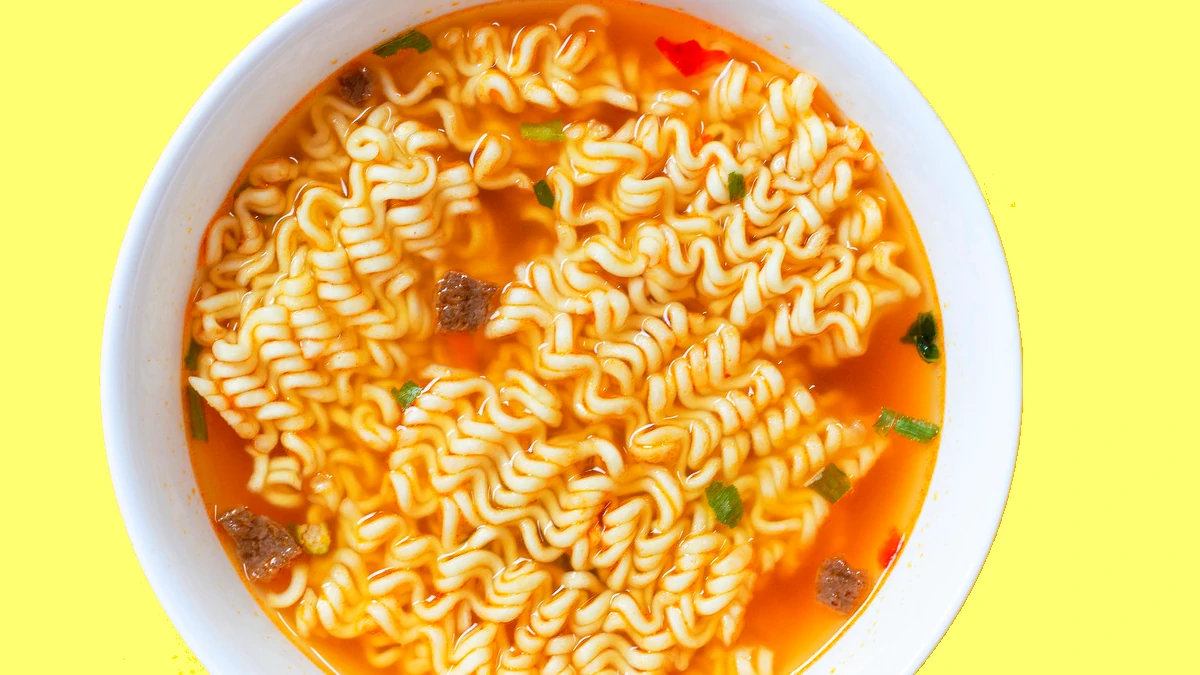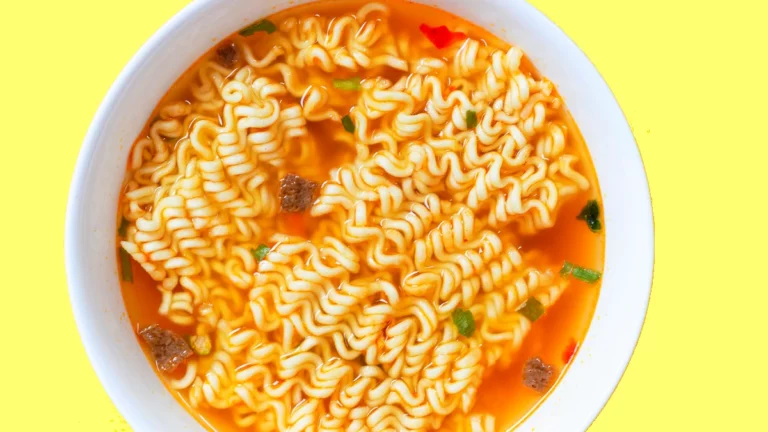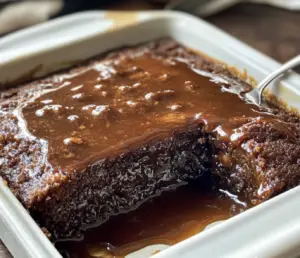Top Ramen, synonymous with quick, easy, and tasty meals, has a fascinating history dating back to post-war Japan. It was invented as a convenient food option that could be easily stored and prepared, making it an instant hit among the masses. Today, it’s not just a food item; it’s a cultural icon celebrated for its versatility and ability to adapt to various tastes worldwide. How Many Calories in Top Ramen ?

Why It’s a Popular Choice Worldwide:
The global popularity of Top Ramen can be attributed to several factors:
- Its affordability makes it accessible to a broad audience, from students on a tight budget to families looking for a cost-effective meal option.
- The ease of preparation is unbeatable. A comforting bowl of noodles is ready to be enjoyed with just a few minutes and some hot water.
- The variety of flavors caters to diverse palates, ensuring a Top Ramen for everyone.
The appeal of Top Ramen goes beyond just taste and convenience. In many ways, it represents a blank canvas for culinary creativity. From the streets of Tokyo to the kitchens of home cooks in the United States, Top Ramen has been reinvented countless ways, incorporating localingredients to create new and exciting dishes. This adaptability has cemented its place in the hearts and stomachs of people worldwide.
As we dive deeper into the nutritional aspects and health considerations of consuming Top Ramen, it’s important to remember that moderation is vital. While Top Ramen can be part of a balanced diet, it’s crucial to be mindful of its nutritional content and how we can make it a healthier meal option. Stay tuned as we explore these topics and more, providing you with all the information you need to enjoy Top Ramen in the most beneficial way possible.
Nutritional Overview of Top Ramen
Understanding Calories in Top Ramen
Before diving into Top Ramen‘s nutritional content, let’s take a moment to understand what calories are. But calories are a measure of energy our bodies get from our food. They are essential for maintaining bodily functions and supporting physical activity. However, consuming more calories than the body needs can lead to weight gain, making it necessary to balance calorie intake with calorie expenditure.
Nutritional Content of Top Ramen
A single serving of Top Ramen, particularly the chicken flavor, contains approximately 380 calories. This calorie count is a combination of carbohydrates, proteins, and fats. Specifically, Top Ramen packs around 53 grams of carbs, 14 grams of fat, and 9 grams of protein. While these macronutrients are vital for energy and bodily functions, the high carb and fat content and the low protein value make Top Ramen a meal that should be consumed in moderation.
The sodium content in Top Ramen is also noteworthy, with a single package containing over 1,000 milligrams. Considering that the American Heart Association recommends no more than 2,400 milligrams of sodium per day, which is milligrams for most adults, Top Ramen‘s sodium levels are something to be mindful of, especially for those monitoring their salt intake.
Comparison with Other Instant Noodles
Compared to other instant noodles, Top Ramen falls within the average range in terms of calories, sodium, and macronutrient distribution. However, it’s the simplicity and the flavor profile of Top Ramen that often sets it apart. While nutritional content is a significant factor, the choice between different brands of instant noodles often comes down to personal preference regarding taste and texture.
To make Top Ramen a more balanced meal, consider adding vegetables, lean protein, or a boiled egg. These additions can enhance the meal’s nutritional value, providing more vitamins, minerals, and fiber, making it a more satisfying and healthier option.
In instant noodles, Top Ramen continues to be a beloved choice for many. However, being informed about its nutritional content and understanding how it fits into your overall diet can help you enjoy Top Ramen satisfyingly and mindfully to achieve your health goals. As we move forward, we’ll delve into the health implications of regular Top Ramen consumption and offer tips for making your noodle dish healthier. Stay tuned for more insights and recommendations on enjoying your favorite comfort food in the most beneficial way possible.
Health Considerations
Health Implications of Consuming Top Ramen
Indulging in a bowl of Top Ramen might be a comforting and convenient choice, but considering the health implications of making it a staple in your diet is crucial. The high sodium content, for one, can lead to increased blood pressure and a higher risk of heart disease and stroke if consumed excessively. Moreover, the preservatives and additives in instant noodles, such as TBHQ, have raised health concerns, although they remain within FDA-approved levels.
Another aspect to consider is the lack of essential nutrients. Top Ramen, while satisfying, doesn’t offer a significant amount of vitamins, minerals, or fiber. Regular consumption could lead to nutritional deficiencies if not balanced with other nutrient-rich foods. Furthermore, the high carbohydrate and fat content, with a relatively low protein level, may not align with the nutritional needs of those on specific diets or with particular health goals.
How to Make Top Ramen Healthier
Fortunately, there are several ways to make your Top Ramen meal healthier and more balanced. Here are a few tips:
- Add Vegetables: Incorporating vegetables like spinach, carrots, or bell peppers can boost the fiber, vitamin, and mineral content of your meal.
- Include Protein: Adding a source of lean protein, such as chicken, tofu, or a soft-boiled egg, can increase the nutritional value and make the meal more filling.
- Reduce the Seasoning Packet: To lower sodium, consider using only half of the seasoning packet and adding your herbs and spices for flavor.
- Use Whole Grain Noodles: Some brands offer whole grain or higher fiber noodles, a healthier alternative to the traditional Top Ramen noodles.
By making these adjustments, you can enjoy Top Ramen as part of a balanced diet without significantly compromising your health goals.
Dietary Concerns
Top Ramen in Different Diets
Top Ramen can be adapted to fit various dietary preferences and restrictions with creativity and modification.
- Keto: Traditional Top Ramen noodles are too high in carbohydrates for those following a ketogenic diet. However, you can substitute the noodles with shirataki or zucchini noodles and use the seasoning packet sparingly to keep within your carb limit.
- Vegan: Top Ramen offers certain flavors that are vegan-friendly. Always check the ingredients list to ensure no animal-derived products are included. Enhance your vegan Top Ramen with tofu and an assortment of vegetables for a nutritious meal.
- Gluten-Free: While traditional Top Ramen noodles contain wheat, gluten-free alternatives mimic the texture and taste of regular noodles. Pair these with the seasoning you choose, keeping an eye out for any gluten-containing additives.
Adapting Top Ramen to fit these dietary concerns allows everyone to enjoy this versatile dish, regardless of their dietary restrictions or preferences. Creativity makes Top Ramen a convenient base for various healthy and delicious meals.
As we continue exploring Top Ramen’s world, remember that balance and moderation are essential. Whether enjoying it as a quick snack or incorporating it into a larger meal, being mindful of the nutritional content and making healthier choices can enhance your overall dining experience. Stay tuned for our next section, where we’ll answer frequently asked questions about Top Ramen and delve deeper into how to enjoy it responsibly.
FAQs Based on ‘People Also Ask’
In this section, we’ll address some of the most common questions related to Top Ramen, shedding light on concerns and curiosities that many noodle enthusiasts share.
How Many Calories are in Top Ramen ? ( Calories in Top Ramen )
A standard package of Top Ramen, particularly the chicken flavor, contains about 380 calories. This figure can vary slightly depending on the taste and additional ingredients you might add to your bowl. Considering these calories as part of your daily intake is essential, especially if you’re monitoring your calorie consumption for weight management or health reasons.
Nissin Top Ramen Chicken Flavor (0.5 ramen) contains 26g total carbs, 25g net carbs, 7g fat, 5g protein, and 180 to 200 calories.
Can Top Ramen be part of a healthy diet?
Yes, Top Ramen can be part of a healthy diet when consumed in moderation and with mindful modifications. You can create a more balanced meal by adding vegetables and lean protein and reducing the use of the seasoning packet. However, due to its high sodium content and lack of essential nutrients, enjoying Top Ramen and other nutrient-rich foods is advisable.
How does Top Ramen compare to other instant noodles in terms of calories?
Top Ramen falls within the average calorie range for instant noodles, with most varieties hovering around 300 to 400 calories per package. The critical difference often lies in each brand’s flavorings and specific formulations, which can affect the sodium, fat, and additive content. When choosing between instant noodles, consider the calorie content, nutritional profile, and ingredient list.
You can replace ‘top ramen’ with Pasta Italiana
As we wrap up our comprehensive journey through the world of Top Ramen, it’s clear that this iconic noodle dish holds a special place in the hearts and kitchens of many. Top Ramen has proven its versatility and enduring appeal from its humble beginnings to becoming a global phenomenon. However, as with any food item, especially those within the instant noodle category, understanding its nutritional content and potential health implications is crucial for making informed dietary choices.
Incorporating Top Ramen into a balanced and healthy diet requires a bit of creativity and a willingness to modify traditional preparation methods. By adding fresh vegetables, opting for lean proteins, and being cautious with the seasoning packet, Top Ramen can transform from a simple snack into a nutritious meal. Furthermore, exploring dietary variations ensures that individuals following keto, vegan, or gluten-free diets can still enjoy the comfort and convenience of Top Ramen with a few adjustments.
The conversation around Top Ramen and its place in a healthy diet also opens up broader discussions about convenience foods, nutritional awareness, and the importance of dietary diversity. While Top Ramen can undoubtedly be part of a healthy eating plan, it should be complemented with other foods rich in essential nutrients to ensure a well-rounded diet.




